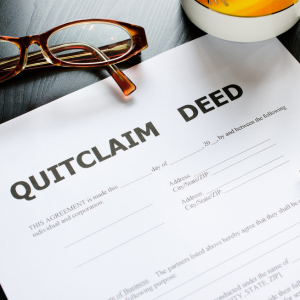
Understanding The Basics: What You Need To Know About Quitclaim Deeds In California
Knowing the basics of a quitclaim deed is important if you want to change who owns a piece of property in California. This legal document makes it possible for property to be given from one person to another without any guarantee of the title to the property.
Keep in mind that a quitclaim deed doesn’t offer any guarantees or warranties about the property’s title. This makes it a riskier choice than other types of deeds. But it can be useful in some situations, like when family members want to share property or when adding or removing a spouse from the title.
To file and record a quitclaim deed in California, you need to do certain things, like fill out the right forms and pay any fees that are due. If you know how to do this, you can be sure that the legal transfer of your real estate ownership follows California law.
TABLE OF CONTENTS
- Understanding The Basics: What You Need To Know About Quitclaim Deeds In California
- Defining Warranty Deeds And Grant Deeds: A Comparison To Quitclaim Deeds In California
- The Step-by-step Guide To Filing A Quitclaim Deed In California
- Calculating Costs: The True Price Of A California Quitclaim Deed
- Navigating Tax Implications: How A Quitclaim Deed Can Impact Your Finances In California
- The Intersection Of Mortgages And Quitclaim Deeds: What You Need To Know
- Real-Life Examples: Reader Success Stories With California Quitclaim Deeds
- Contact Information Made Simple: Address And Phone Details For Filing A Quitclaim Deed In California
- Connecting With Us: How To Get In Touch Regarding Your California Quitclaim Deed
- Streamlining The Process: Using Nolo’s California Quitclaim Deed Form For Easy Preparation And Recording
- Preparing Your Quitclaim Deed: Steps You Must Take Before Filing In California
- Common Uses For Quitclaim Deeds: Understanding When This Type Of Transfer Is Appropriate
- Identifying New Owners And Their Title On A California Quitclaim Deed: Best Practices
- Getting It Right: Entering The Legal Description Of Your Property On A California Quitclaim Deed
- The Role Of Notarization In Filing A Valid California Quitclaim Deed
- Transferring Property Between Family Members With A California Quitclaim Deed
- Where Can I Get A Quit Claim Deed Form For California?
- What Are The Disadvantages Of A Quit Claim Deed?
- Do You Pay Taxes On A Quitclaim Deed In California?
Defining Warranty Deeds And Grant Deeds: A Comparison To Quitclaim Deeds In California

California allows for multiple types of deeds to transfer real estate ownership. Warranty and grant deeds are the two most common options.
Both types of deeds guarantee to the buyer that the property is free of liens and encumbrances. In cases where the title is uncertain, a quitclaim deed may be a more suitable option.
Unlike warranty and grant deeds, quitclaim deeds make no guarantees regarding title. Instead, they transfer the seller’s interest in the property to the buyer.
Quitclaim deeds are useful for family transfers, divorce settlements, and other situations involving ownership rights.
The Step-by-step Guide To Filing A Quitclaim Deed In California
In California, transferring real estate ownership requires a quitclaim deed. To ensure that the process runs smoothly and legally, the necessary steps must be carefully followed.
The first step is to obtain a blank quitclaim deed form, which can be found at the county recorder’s office or downloaded online. The transfer requires both parties to sign the document in front of a notary public.
The signed and notarized deed must then be filed with the county recorder’s office for the property’s location. In addition to the deed, a Preliminary Change of Ownership Report and transfer tax forms must be submitted.
After filing all required documents and paying fees, the county recorder will record the quitclaim deed and update the property’s title. It is important to note that this process may differ slightly by county, so check with your local recorder’s office for any specific requirements or procedures.
To successfully transfer ownership of your California real estate property, follow these steps when filing a quitclaim deed.
Calculating Costs: The True Price Of A California Quitclaim Deed

The cost of filing and recording a California quitclaim deed for real estate ownership is an important consideration. While this type of deed may appear to be a simple and cost-effective method of transferring property ownership, several expenses must be considered.
Fees for preparing a deed include notary fees, recording fees at the county clerk’s office, and potential taxes or penalties. Furthermore, if the property already has a mortgage, obtaining a release of liability from the lender may incur additional costs.
Before signing a quitclaim deed, it’s crucial to calculate all expenses to understand the true cost of the process.
Navigating Tax Implications: How A Quitclaim Deed Can Impact Your Finances In California
When transferring real estate ownership in California, understanding the tax implications of a quitclaim deed is essential. This type of deed allows for the transfer of property ownership without warranties or guarantees, which can have serious financial consequences.
A quitclaim deed may trigger gift or capital gains taxes, so consult a tax professional before filing and recording. Furthermore, if the property has an outstanding mortgage, there may be consequences for both parties involved in the transaction.
Before executing a quitclaim deed in California, it’s crucial to conduct thorough research and understand all potential tax implications.
The Intersection Of Mortgages And Quitclaim Deeds: What You Need To Know

When it comes to transferring real estate ownership in California, understanding the relationship between mortgages and quitclaim deeds is critical. A quitclaim deed transfers ownership without guarantees or warranties, which may affect existing mortgages on the property.
Before filing a quitclaim deed, review any mortgage agreements to ensure compliance with terms and conditions. Additionally, obtaining written consent from all parties involved, including lenders and co-owners, is required to avoid potential legal issues later on.
Individuals who master this process and are aware of the potential implications for mortgages can successfully file and record a California quitclaim deed for real estate ownership.
Real-Life Examples: Reader Success Stories With California Quitclaim Deeds
Many people have successfully transferred real estate ownership using a California Quitclaim Deed. Jane, for example, inherited her family’s vacation home in California but wanted to change the title to reflect her husband’s name.
Jane quickly and legally transferred ownership to herself and her husband by following the steps outlined in Mastering The Process: How to File and Record a California Quitclaim Deed. John successfully removed his ex-wife’s name from their shared property title after their divorce using a quitclaim deed.
John was able to easily navigate the process and achieve his desired result, thanks to the clear instructions provided in this guide. These real-world examples show how useful and effective a California Quitclaim Deed can be when used correctly.
Contact Information Made Simple: Address And Phone Details For Filing A Quitclaim Deed In California
If you want to file a quitclaim deed for real estate ownership in California, you need to have the correct contact information. First, the address for filing a quitclaim deed depends on the county where the property is located.
Generally, it must be filed with the county recorder or assessor’s office. You can find their exact addresses online or by contacting local government offices.
Additionally, you must include a valid phone number on the deed so that you can be contacted if necessary. Before submitting your quitclaim deed, double-check the information to ensure a successful filing process.
Connecting With Us: How To Get In Touch Regarding Your California Quitclaim Deed
If you want to file and record a California quitclaim deed for real estate ownership, you must first understand the process and gather all necessary information. That’s where we step in.
Our experts at Eazy House Sale are dedicated to assisting individuals in navigating the complexities of filing a quitclaim deed in California. We are committed to providing seamless and efficient services to ensure a smooth transfer of real estate ownership.
Whether you have questions about the process or need help filling out forms, our experienced professionals are here to help you every step of the way. You can contact us by phone, email, or in person to receive personalized assistance with your California quitclaim deed.
Don’t hesitate to contact us with any questions or concerns; we’re here to help make your real estate transaction successful.
Streamlining The Process: Using Nolo’s California Quitclaim Deed Form For Easy Preparation And Recording

Filing and recording a California quitclaim deed for real estate ownership can be a complex and time-consuming process. However, with the help of Nolo’s California quitclaim deed form, this process can be streamlined and made much easier.
This form provides a comprehensive guide for preparing and recording the deed, ensuring that all necessary information is included and in the correct format. By using this form, individuals can avoid common mistakes that may delay or complicate the filing and recording process.
With its user-friendly layout and clear instructions, Nolo’s California quitclaim deed form is an essential tool for mastering the process of transferring real estate ownership through a quitclaim deed in California.
Preparing Your Quitclaim Deed: Steps You Must Take Before Filing In California
Before filing a California quitclaim deed for real estate ownership, you must prepare and take the necessary steps. To transfer ownership, ensure the deed includes all necessary information, including the property description and grantor and grantee names.
Next, obtain and complete a preliminary change of ownership report from the county recorder’s office. Before filing a quitclaim deed, any existing liens or encumbrances on the property must be resolved.
Consult a lawyer or title company to ensure legal compliance and prevent future issues. Finally, in order for the deed to be legally binding, it must be signed before a notary public and recorded at the county recorder’s office.
Follow these steps to properly prepare your quitclaim deed for filing in California.
Common Uses For Quitclaim Deeds: Understanding When This Type Of Transfer Is Appropriate

Transferring property ownership in California requires the execution of a Quitclaim Deed. Important for property owners who want to change ownership percentages, add or remove names from the title, or transfer property between family members.
Common uses for this type of deed include property transfers within families, gifts, and divorces. Possibilities for property ownership disputes can also be resolved using this method.
Only when all parties are in complete agreement and have complete faith in each other should a Quitclaim Deed be utilized; after all, it does not ensure a clear title. So, to make sure this transfer is right for you, it’s a good idea to learn about the typical uses of quitclaim deeds.
Identifying New Owners And Their Title On A California Quitclaim Deed: Best Practices
When filing a California quitclaim deed for real estate ownership, it is critical to accurately identify the new owners and their titles. This ensures that the transfer of ownership is legal and correct.
First, obtain a copy of the current property deed to confirm the owner’s name and any existing liens or encumbrances. Next, all parties must sign the quitclaim deed before a notary public.
Before transferring ownership, conduct a thorough title search to identify any potential issues. Additionally, it is critical to accurately record all names and titles on the deed to avoid future legal complications.
By following these best practices, you can ensure a smooth and successful transfer of ownership using a California quitclaim deed.
Getting It Right: Entering The Legal Description Of Your Property On A California Quitclaim Deed

When submitting a Quitclaim Deed in California to establish actual property ownership, it is critical to provide the correct legal description of the property. This process requires accurately identifying and describing the boundaries and specifics of the property being transferred.
All information must be verified and ensured that it is consistent with official records and documents. Inconsistencies or errors in the legal description have the potential to lead to future legal problems.
To avoid problems of this nature, it is recommended that you consult with a professional or conduct extensive research on the legal description of the property before submitting the Quitclaim Deed. Taking the time to enter this information correctly will ensure that the transfer of ownership goes smoothly and avoids future complications.
The Role Of Notarization In Filing A Valid California Quitclaim Deed
The filing of a valid quitclaim deed for real estate ownership in the state of California must include notarization. One way to ensure that all parties’ identities are confirmed is to have a licensed notary public witness the signing of the deed. This process is known as notarization.
This is an essential step in making sure the deed is carried out freely and without any form of pressure or compulsion. The presence of a neutral third party at the time of the signing of the deed is further evidence that the signatures are authentic upon notarization.
The failure to properly notarize a quitclaim deed can render it invalid and cause future legal complications. Thus, to ensure the California quitclaim deed is valid and to prevent problems with transferring property ownership, it is crucial to adhere to all notarization requirements when getting one.
Transferring Property Between Family Members With A California Quitclaim Deed

Transferring property between family members can be a difficult and stressful process. However, with the assistance of a California quitclaim deed, this process can be greatly streamlined.
This legal document transfers real estate ownership from one family member to another without the need for a traditional sale or purchase transaction. Using a quitclaim deed, individuals can easily transfer their property rights to a family member, eliminating the need for outside buyers or sellers.
This method is especially useful for families who want to keep their real estate within the family while avoiding potential tax implications associated with other types of property transfer. Filing and recording a California quitclaim deed can provide peace of mind and smooth property transfer between family members with proper guidance.
Where Can I Get A Quit Claim Deed Form For California?

In California, getting the right form is one of the first things you need to do if you want to transfer your property through a quitclaim deed. You can easily get a quitclaim deed form in California, thanks to the many options available.
Get the form from the county recorder’s office where the property is located. This is the safest and most convenient option. You can also buy the form at a legal stationery store or download it from the California government’s website.
Make sure you have the correct and most recent version of the quitclaim deed form to prevent the filing and recording of your document from taking too long or being difficult to understand.
What Are The Disadvantages Of A Quit Claim Deed?
Although a California quitclaim deed can be an effective tool for transferring real estate ownership, it is critical to understand its drawbacks. One significant disadvantage is that the grantee (the person receiving the property) is not guaranteed a clear title to it.
This means that if there are any undisclosed liens or claims on the property, the grantee is responsible for addressing them. Furthermore, a quitclaim deed does not include any warranties or guarantees from the grantor (the person giving away the property).
This means that if there are any problems with the property after it has been transferred, the grantee cannot hold the grantor accountable. Finally, using a quitclaim deed may have tax implications for both parties involved in the transaction.
Before executing a quitclaim deed, carefully consider these factors and consult with a legal professional.
Do You Pay Taxes On A Quitclaim Deed In California?
When it comes to filing and recording a California quitclaim deed for real estate ownership, one frequently asked question is whether taxes must be paid on the transaction. The answer is both simple and complicated.
In California, the transfer of ownership via quitclaim deed is generally tax-free. However, in some circumstances, taxes may still apply.
For example, if the property being transferred has an outstanding mortgage or if the ownership percentage changes, taxes may be due. It is critical to understand these nuances and consult with a tax professional before filing and recording a California quitclaim deed.
Individuals who master this process can ensure that their real estate ownership transfer goes smoothly and without any unexpected tax consequences.
This information applies to California and its cities, including Los Angeles, Long Beach, Norwalk, Inglewood, Santa Monica, and more. For assistance or questions, please call us at (855) 915-1382. You can also visit our website at Eazy House Sale for more details.
See More Resources For Selling Your California Property
| QUICK CLAIM DEED | ATTORNEY | ATTORNEY AT LAW | LAWYERS | OWNERSHIP INTEREST | REAL ESTATE LAW |
| BREACH OF WARRANTY | WARRANTY OF TITLE | IMPLIED WARRANTY | LICENSING | GRANTORS | EXEMPTION |
| TAX EXEMPTIONS | REAL PROPERTY | LEGAL CONCEPT | PREMIUM | INSURERS | INSURANCE |
| INSURANCE COMPANY | INSURANCE COMPANIES | TENANTS IN COMMON | JOINT TENANTS | RIGHT OF SURVIVORSHIP | CO-OWNERSHIP |
| TITLE INSURANCE | TITLE COMPANIES | COMMUNITY PROPERTY | MARRIAGE | MARRIED COUPLE | MARITAL |
| HUSBAND AND WIFE | CONTRACT | REVOCABLE LIVING TRUST | SACRAMENTO | POSTAL CODE | ZIP CODE |
| TITLE SEARCHES | SUBDIVISION | MAP | LOS ANGELES COUNTY | LOS ANGELES | COVENANT OF QUIET ENJOYMENT |
| TENANTS | LANDLORD AND TENANT | ESTATE PLANNING | ESTATE-PLANNING | COVENANT | CHILDREN |
| EASEMENT | AMERICAN | COUNTY ASSESSOR | SACRAMENTO COUNTY | REASON | PRIVACY |
| PLAT | PAYMENT | METES AND BOUNDS | MESSAGE | LLC | LEGAL ADVICE |
| LAW FIRM | COOKIES | FREQUENTLY ASKED QUESTIONS | FAQS |


